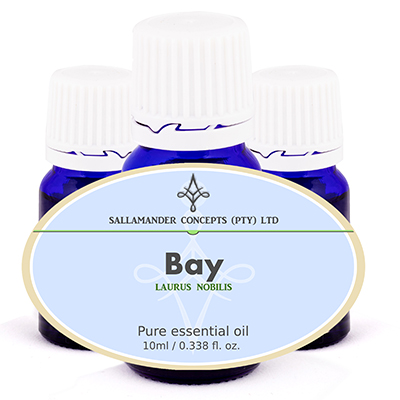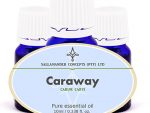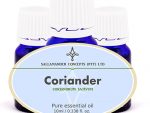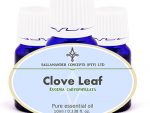Bay essential oil information
West Indian Bay essential oil is extracted from the Pimenta racemosa tree, of the Myrtaceae family. Common names include West Indian bay tree, bay rum tree, and ciliment.
Properties
The scent of bay oil is sweet, fresh and spicy and the oil is deep yellow in color, being of medium to watery viscosity.
Origin
This sturdy evergreen tree is a native of West Indies, Morroco and the Spain. Nowadays the oil is obtained mostly from Morocco and Spain. The bay tree grows to about 10 meters (30 feet), has long aromatic lance-shaped leaves, small white-yellow flowers and black berries.
Bay oil was very popular with the Romans, who thought that the herb was symbolic of wisdom, peace and protection. The Latin ‘Laudis’ means ‘to praise”, which is why the victors at the Olympic games were presented with a laurel (bay) wreath.
In the past, bay leaves were distilled with rum and the “bay-rum” so obtained was a famous hair tonic and body rub for colds and muscle pains .
Extraction
The leaves are collected from a tree that is at least 5 years old and are typically subjected to steam distillation (salt is often added or seawater used in the still). The extraction usually yields about 0.5-1.5%.
Chemical composition
The chemical typical composition of bay essential oil includes; a-pinene, b-pinene, myrcene, limonene, linalool, methyl chavicol, neral, a-terpineol, geranyl acetate, eugenol and chavicol.
Precautions when using Bay essential oil
Bay essential oil has a high eugenol content and may irritate the skin and mucus membranes, so it should be used with caution on the skin. We suggest using very low dilution rates (View Suggested Dilution Rates below).
Please read our page with heading: Safety with Essential Oils before using this oil.
We recommend the following book as an excellent resource regarding safety:
Essential Oil Safety: A Guide for Health Care Professionals by Robert Tisserand & Rodney Young (#ad)
Therapeutic properties
The therapeutic properties of bay oil include; antiseptic, antibiotic, analgesic, anti-neuralgic, antispasmodic, aperitif, astringent, emmenagogue, febrifuge, insecticide, cholagogue, sedative, stomachic, sudorific and tonic.
Uses
Bay oil can be used in the treatment of rheumatism, neuralgia, muscular pain, circulation problems, colds, flu, dental infection, hair growth, general health of the scalp, diarrhea and skin infections.
Summary
The benefit of bay oil lies in its calming and warming effect on emotions and general aches and pains, including rheumatic pains. It also settles the digestive system, excess gas and also acts as a tonic on the liver and kidneys. In small amounts it has a stimulating effect, while larger doses produce a sedating effect.
Bay essential oil is also helpful with hair and scalp conditions and is mostly used to combat hair loss. Bay essential oil is used with success in treating sprains, strains and bruises.
Suggested dilution rates
On the skin
Healthy adult with unbroken skin
- Face and Neck: 0.25% to 0.9%
- Body: 0.25% to 0.9%
- Bath: 0.25% to 0.9%
Infant up to to 24 months:
- Do NOT use
- Do NOT use on the skin when breastfeeding
Young Child from 2 years to 6 years:
- Face and Neck: Avoid
- Body: up to 0.25%
- Bath: up to 0.25%
Child from 6 years to 15 years:
- Face and Neck: 0.25% to 0.9%
- Body: 0.25% to 0.9%
- Bath: 0.25% to 0.9%
In Pregnancy and when breastfeeding:
- Certain professionals use Bay essential oil in pregnancy – to a maximum dilution rate of 0.5%.
- When in doubt consult your doctor / medical professional before use.
- Most professionals and/or Aromatherapists will always err on the side of safety due to conflicting information available – quite a number of Aromatherapists advise that you avoid essential oils completely while pregnant, specifically during the first trimester.
- We suggest that this oil be avoided when breastfeeding.
General:
- When using for the first time – Always use the lowest dilution rate and build up slowly to the maximum. Stop using all essential oils on the skin if irritation or allergy occurs.
- Any advice or instruction received from a medical professional ALWAYS supersedes recommendations or advice found on this website. When in doubt consult your doctor / medical professional.
Burners and vaporizers
In vapor therapy (use 2 to 8 drops), bay oil can be used for an infection, for fever and general aches and pains. It can trigger inspiration and has a calming effect on the mind.
Bay oil blends well with
Bay oil blends well with other oils, including cedarwood, coriander, eucalyptus, geranium, ginger, juniper, lavender, lemon, orange, rose, rosemary, thyme and ylang-ylang.





